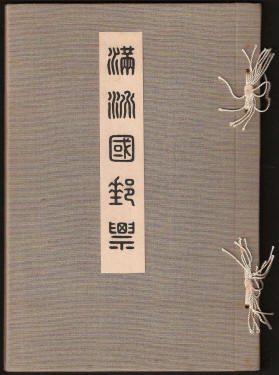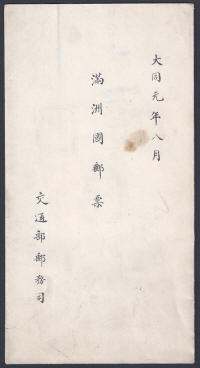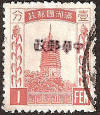 |
||||||||
|
|
|
|||||||
|
|
Postage Stamps Manchukuo Year 1 大同 Datong State of Manchukuo (First Regular Issue) This is the first set of stamps representing the new state of Manchukuo. The stamps went on sale on 26th July 1932, and the set contains eighteen values. Looking at the list of postal rates shown separately it is hard to see how some values would have been used, which might mean that the level of pricing had not been agreed at the time of printing. The stamps were lithograph printed on un-watermarked white paper in sheets of 100 by the Japanese Government Printing Office in Tokyo. Designs by Mr YOSHIDA Yutaka and dies made by AOKI Miyakichi. A number of presentation folders were made for this issue which are sought after by collectors. The stamps are 18.8mm x 22.5mm. Perf 13 x 13½. The ½fen to 10fen stamps depict the White Pagoda. This is a 13 story 70m tower, carved with images of the Buddha and stands in Paita Park in the city of Liao-yang, 64 kilometres South of Mukden. The pagoda is all that remains of the once important Guan Yu temple. The remainder of the issue 13fen to 1Yuan show the Chief Executive of Manchukuo, Puyi, later to become Emperor Kāngdé. In reality Puyi had no power and was completely under the control of the Japanese. Note that this issue has five characters in the top banner reading "Manchu State Postal Administration".
|
|||||||
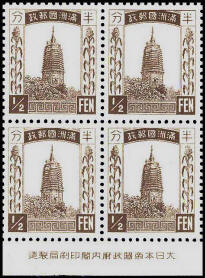
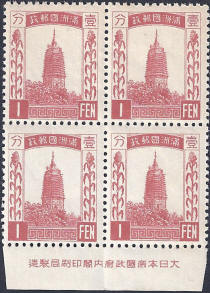
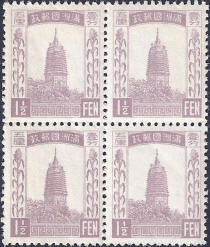 |
||||||||
|
11,500,000 |
42,500,000 | 1,250,000 | ||||||
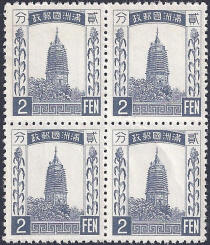
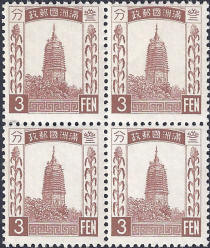
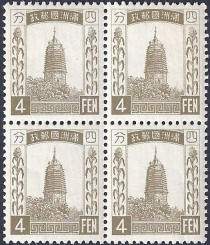 |
||||||||
| 4,310,000 | 1,200,000 | 50,000,000 | ||||||
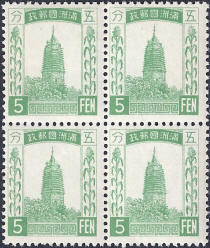
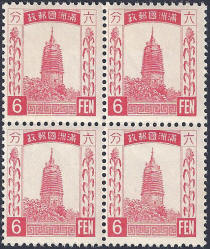
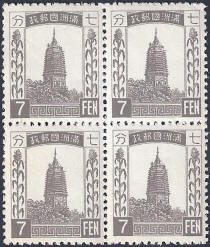 |
||||||||
| 2,550,000 | 560,000 | 1,260,000 | ||||||
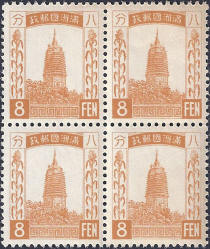
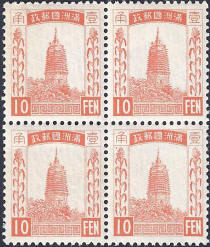
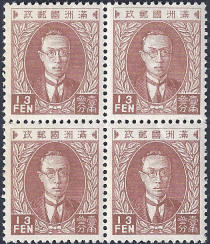 |
||||||||
| 470,000 | 3,530,000 | 450,000 | ||||||
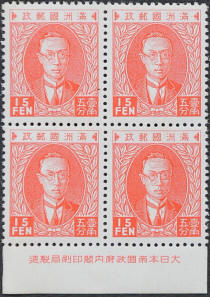
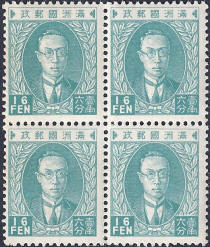
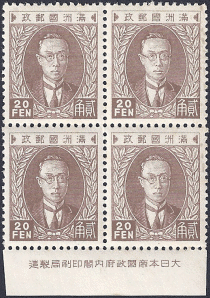 |
||||||||
| 750,000 | 2,600,000 | 1,500,000 | ||||||
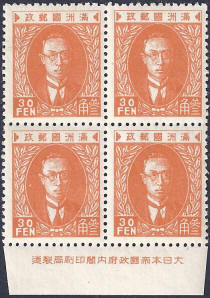
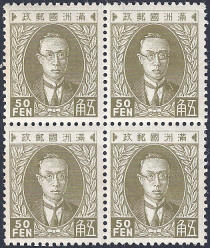
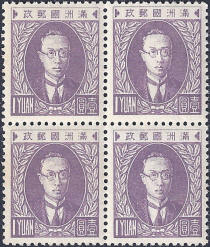 |
||||||||
| 750,000 | 1,000,000 | 500,000 | ||||||
Most sources claim that the first 2,000 sheets of each value had an imprint of 14 characters 大日本帝國國政府内閣印刷局製造 which reads "Manufactured by the Imperial Japanese Cabinet Printing Bureau" (Dainippon Teikoku Seifu Insatsukyoku Seizō). It is probable that more than 2,000 sheets were imprinted for some values, particularly the 4f which was the standard letter rate in 1932. This would explain why surplus stock of of the 4f could be found to be surcharged in 1934. This imprint occurred at the centre of the bottom margin. A block of stamps with the margin containing all 14 characters is considered very desirable by collectors. A 5f light blue can sometimes be found in collections. This is not a variety, the colour of these has been chemically altered to make them attractive to collectors. |
||||||||
|
The First Special Presentation Album and Souvenir Folder Above is the cover of the first Special Presentation Booklet issued for use by U.P.U. members and as gifts for important officials. Inside are three pages with samples of the 18 stamps in the above set, plus three further pages with samples of a 1f, 2f, and 15f postcard. To see the booklet in detail please click here. The souvenir folder simply contains a set of the first 18 stamps issued by Manchukuo glued onto a folded card. To see these please click here.
|
||||||||
|
The General Su Ping-Wen Overprint
General Su Ping-Wen was the Chinese Commander in charge of the Manchurian troops guarding the Chinese Eastern Railway, based at Hailar. He mutinied against the Government of Manchukuo and Japanese rule on 27th September 1932. Initially he was quite successful and was able to sieze and hold the towns of Hailar and Manchouli before being forced to retreat with his army into Russia in December of the same year. The railway to Siberia runs through Manchouli and as a consequence of the occupation, mail to Europe from Manchukuo had to be diverted via America or Canada, or else via Suez. During the time General Su Ping-Wen was in control he required post offices within the captured area to overprint stamps with a wooden chop - four characters reading "Chinese Postal Administration". This chop was applied in black or vermillion and was intended to be placed over the five characters at the top of the first regular issue stamps that read "Manchu State Postal Administration". There is no record of how many stamps with this overprint were issued, but what is certain is that for every genuine overprint many fakes exist. The stamp shown below is likely to be an example of this and any stamps that you might find with a similar chop should be treated with suspicion.
|
||||||||
|
|
||||||||

